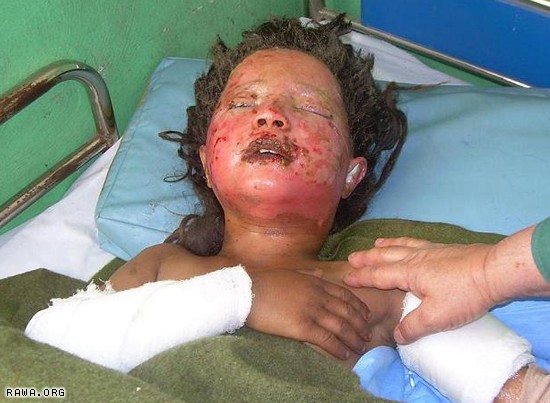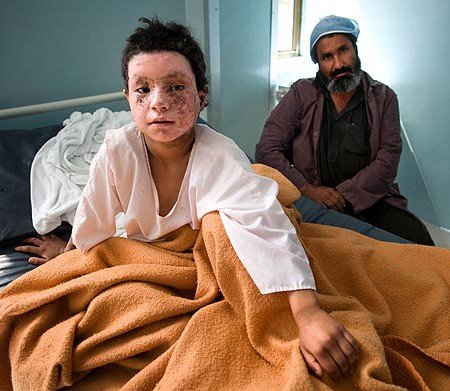By Shapoor Saber and Fetrat Zerak in Farah and Abaceen Nasimi in Kabul
America pledges to reduce price paid by civilians in war against Taliban, but disputes Afghan estimates for Farah airstrike death toll.
Sayed Karim, 72, is now all alone. The elderly, white bearded man bowed his turbaned head as he told of the 13 members of his family who were killed in a May 4 airstrike by United States forces in Farah province, on Afghanistan’s western border.
“I am no longer young,” he sighed. “I cannot build a new life.”

A 12-year-old injured girl, victim of Bala Baluk strikes recovering in in Farah Civil Hospital. (Photo: RAWA)
(more photos)
On May 4, 2009, US-led Coalition forces provided air support to Afghan national police and army in a battle with insurgents in Ganjabad and Granai, two areas of Bala Baluk, one of the most unstable districts in the remote and volatile province.
The bombardment left a large number of civilians dead, although the exact figure is disputed. But according to the Afghan government’s tally, it is the largest loss of non-combatants in a single military action.
Farah governor Ruhul Amin told IWPR that 30 Taliban died in the clashes, some of them clearly foreign fighters, from Pakistan and Chechnya. Amin estimates that more than 100 civilians were killed, and many others wounded. The victims included women and children.
A Kabul government commission determined that 140 civilians died; some local villagers claim that the figure is even higher. But the US military rejects these counts, saying that the real number is closer to 20 or 30.
“A review of the physical evidence is inconclusive in determining the exact number of civilian and insurgent casualties,” read a press release issued on May 20 by USFOR-A, the office of the US forces in Afghanistan. “In all, the investigation team estimates that 60-65 [Taliban] extremists were killed in these engagements, while at least 20-30 civilians may have been killed during the fighting.”
The exact number of casualties is difficult to establish because many of the slain were buried in a common grave.
Local residents say that the bodies were so mangled that it was hard even for close relatives to identify the remains. Villagers collected body parts and placed them in one grave, 10 metres long by three metres wide.
In addition to the mass burial site, more than 40 individual graves speak of the tragedy suffered by villagers on May 4. Two weeks later, some people were still searching among the rubble with picks and shovels, trying to find their loved ones.
THE BATTLE
According to local residents, fighting broke out in Ganjabad and Granai when a group of approximately 300 Taliban converged on the area to collect ushur and zakat – taxes on income, in this case on the proceeds from the poppy harvest. Afghan national police and army launched a joint operation to drive out the insurgents, but were unable to gain the upper hand.
They asked for backing from the Coalition Quick Reaction Force, which sent troops and air support.
The majority of civilians killed appeared to have been sheltering in compounds belonging to tribal elders, which were struck with 2,000-pound bombs dropped from a B-1 plane.
“It was eight in the evening when the fighting between the government and the Taliban stopped,” said Abdul Mohammad, 35, a resident of Granai. “We thought it was over. But an hour later we heard the drone of the airplanes. I became very nervous and told everyone in my family to get out of the house. There were Taliban around, but when they heard the noise of the planes, they escaped.”
In Farah, said Abdul Mohammad, there is a tradition of seeking sanctuary with local leaders in times of danger. This is what the villagers did, he said, running to two or three of the tribal elders’ compounds.
“All the families, the women and children, did this,” he said. “We thought we would be safe there.”
But around midnight the bombs started falling, targeting the compounds where the civilians were cowering, he continued.
“My wife and two children were martyred,” said Abdul Mohammad. “I was outside, so I was just thrown back by the shock wave and injured slightly. Others were killed by the blast, and by the terrible, terrible smoke.”
Abdul Mohammad weeps constantly and wishes for death. He misses his little girl, Zahra, who was “very sweet and very naughty”.
“How can I live without her?” he cried. “I think of her all the time. This life is worse than death, I wish they had killed me, too.”
WHITE PHOSPHOROUS?
Abdul Mohammad is having a difficult time with an injury, as well.
“At first I had just a small wound on my shoulder, but it has been spreading steadily. I went to Herat for treatment, and you can see, my wound is getting bigger by the day. The doctors say it is caused by some sort of chemical irritant,” he said.

Nazbibi Malham, 9, watched over by her father, Saeed Malham at Herat Regional Hospital. She suffered burns to her face, arms and legs after U.S. forces reportedly hit a mosque and two housing compounds in Garani during clashes with the Taliban. Seven family members were killed and Nazbibi's mother was also burned and is being treated for psychological trauma. (Photo: Holly Pickett/The Times)
Some of those injured in Farah were badly burned – and, in the immediate aftermath of the incident, there was widespread media speculation that one side or the other had used white phosphorous.
Abdul Jabar Shayeq, head of the department of public health for Farah, was reluctant to speculate about the issue. But he acknowledged that some of the injuries were suspicious.
”The wounded people transferred to the central hospital of Farah have terrible signs of burns on their bodies, which clearly indicates that a serious chemical substance was used,” he said. “But we cannot definitely say whether or not it was white phosphorous. It is a dangerous chemical element… We cannot say anything about it, though, because this issue has political dimensions.”
Abdul Manan, a tribal elder who is representing the Farah victims, insists that there was something different about the bombs that fell on the civilians that night.
“These bombs were deadly,” he said. “They had strange pressure and they contained burning materials. When they were dropped, everything caught fire. It was as if the whole earth was burning.”
Abdul Manan said many people died from the fumes.
Experts say that white phosphorous is an unlikely to have been used, since it is not dropped from planes but shot into the air to mask the movements of troops.
Colonel Gregory Julian, spokesperson for the US forces in Afghanistan, told IWPR on May 26 that the white phosphorous rumour had been a deliberate plant by the Taliban.
"White phosphorous was not used by either side – but the Taliban tried to throw that out there to stir up more public outcry," he said, in response to written questions from IWPR.
The burns ward of the Herat regional hospital now houses five patients, from Farah four of them under 15 years of age.
Dr Mohammad Aref Jalali, who heads the burns ward, said that he could not determine whether white phosphorous was the cause of the patients’ injuries, but said that they all had severe burns to their hands and faces.
HEARTS AND MINDS
Farah now joins a long list of incidents that have soured relations between the Afghan government and Washington, as well as between civilians and Coalition forces.
[utube]4P_DqT7BGXc[/utube]Last summer, more than 90 civilians were killed in airstrikes in Herat province; the figure has been substantiated by the Afghan government, the United Nations and numerous media investigations. It is, however, disputed by the US military, which puts the casualty figure closer to 30.
The bombing of a wedding party in Nangahar last August left 47 civilians dead, including the bride; and a band of nomads, or Kuchis, were wrongly identified as insurgents in Herat and killed in February.
But the death toll in Farah could be the highest yet.
US officials say they must do better. Newly-appointed US ambassador Karl Eikenberry, a recently retired general who formerly commanded American forces in Afghanistan, accompanied President Hamid Karzai to Farah on May 19 to express condolences to the survivors.
“I assure the people of Afghanistan that the United States will work tirelessly with your Government, Army, and Police, to find ways to reduce the price paid by civilians, and avoid tragedies like what occurred in Bala Baluk,” he said, in remarks published on the US State Department website. “As US Ambassador, and with my previous experience as a soldier, I make this a solemn pledge.”
Admiral Mike Mullen, chairman of the joint chiefs of staff, reportedly acknowledged that civilian casualties were harming US efforts to implement its new strategy in Afghanistan.
“We cannot succeed in Afghanistan… by killing Afghans,” he told scholars and experts at Washington’s Brookings Institution, according to the Los Angeles Times. “We can’t keep going through incidents like this and expect the strategy to work.”
All sides of the conflict are using the Farah tragedy in the ongoing propaganda war, seeking to further their own cause and damn their enemy.
US forces presented the Farah incident as “a complex series of [Taliban] attacks on innocent civilians”, and strongly condemned the insurgents. “The [Taliban]… deliberately place civilians in harm’s way and callously and cynically manipulate civilian lives for their political purposes,” read the initial press release in the wake of the battle.
The Taliban, for their part, blame the Americans. “The invaders send their forces wherever they want … the Taliban never use civilians as shields,” said Qari Yusuf Ahmadi, spokesman for the Taliban.
“They are not enemies of the people. They are there to defend the people, to defend their rights and their honour, and to defend Islam. The foreigners bomb people. When they are hurt they take it out on the innocent population.”
According to Ahmadi, the Americans lost three tanks, along with 11 soldiers, which caused them to overreact against the civilian population. These figures could not be independently substantiated.
During his trip to Farah, Karzai sought to burnish his image in the run-up to the August elections. He dispensed cash and promises, awarding survivors 2,000 US dollars for each family member killed, and 1,000 dollars for those wounded.
Karzai also tried to distance himself from his US allies, with whom he has been engaged in a long and bitter battle.
“I have been talking to the foreigners about preventing civilian casualties on a daily basis for the past five years,” he told the crowd of mourners in Farah. “I tell them ‘terrorism does not live in the houses and villages of Afghanistan… those who wear turbans and Afghan clothing are not necessarily Taliban. Stop bombing them’.”
Karzai also told the survivors that the government would rebuild their shattered homes and send them all on a hajj to Mecca.
But the Farah bombing is unlikely to help any of the sides in the conflict in their ongoing battle for hearts and minds.
“What can we do?” said Abdul Manaan, shaking his head. “We cannot stand up to either the government or the Taliban. Both sides have guns, and both sides use us as shields. What have we done that we should be the ones getting killed?”
Sayed Karim said he rejected any form of compensation. “I do not want anything from the Afghan government,” he said. “Can they resurrect my lost family?”



